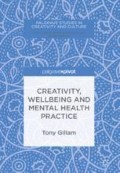Abstract
This opening chapter provides an introduction, an overview and a rationale for the book. It suggests that, while both creativity and wellbeing have become arguably mere buzz-words, in reality they are both complex and useful, interconnected concepts which do have a relevance to contemporary mental health care. Reference is made to Elgar’s association with Worcester asylum as an early example of the connection between creative arts and mental health care. Some autobiographical elements are introduced and creative nonfiction techniques are used to explain the motivations behind writing the book and to illustrate the use of creativity as a foretaste of the book’s themes. The chapter touches on the fashion for creativity and on mental health practice as a creative activity. An outline describes each chapter’s content.
Access this chapter
Tax calculation will be finalised at checkout
Purchases are for personal use only
Notes
- 1.
Gutkind (1997) explains creative nonfiction is a genre that can include memoirs or autobiographical writing and much of what is referred to as literary journalism. Creative nonfiction uses literary devices normally associated with fiction , poetry or drama in the writing of nonfiction stories which strive to be as true, accurate and informative as reportage.
References
Barker, P., & Buchanan-Barker, P. (2005). The tidal model: A guide for mental health professionals. Hove: Brunner-Routledge.
Berg, A., & Hallberg, I. R. (1999). Effects of systematic clinical supervision on psychiatric nurses’ sense of coherence, creativity, work-related strain, job satisfaction and view of the effects from clinical supervision: A pre-post test design. Journal of Psychiatric and Mental Health Nursing, 6(5), 371–381.
de Young, M. (2015). Encyclopedia of asylum therapeutics, 1750–1950s. Jefferson: McFarland.
Department for Culture, Media and Sport. (2016). Creative industries: Focus on employment, June 2016. London: Department for Culture, Media and Sport. Retrieved from: https://www.gov.uk/government/uploads/system/uploads/attachment_data/file/53435/Focus_on_Employment_revised_040716.pdf
Duggan, M., Cooper, A., & Foster, J. (2002). Modernising the social model in mental health: A discussion paper. London: Social Perspectives Network for Modern Mental Health.
Gillam, T. (2002). Reflections on community psychiatric nursing. London: Routledge.
Gutkind, L. (1997). The art of creative nonfiction: Writing and selling the literature of reality. New York: Wiley.
Leckey, J. (2011). The therapeutic effectiveness of creative activities on mental well-being: A systematic review of the literature. Journal of Psychiatric and Mental Health Nursing, 18(6), 501–509.
McNaught, A. (2011). Defining wellbeing. In A. Knight & A. McNaught (Eds.), Understanding wellbeing: An introduction for students and practitioners of health and social care. Banbury: Lantern Publishing Limited.
Nettle, D., & Clegg, H. (2006). Schizotypy, creativity and mating success in humans. Proceedings of the Royal Society of London B: Biological Sciences, 273, 611–615.
Ryan, P., & Morgan, S. (2004). Assertive outreach: A strengths approach to policy and practice. Edinburgh: Churchill Livingstone.
Seligman, M. E. P. (2011). Flourish: A new understanding of happiness and well-being – and how to achieve them. London: Nicholas Brealey Publishing.
Seligman, M. E. P., & Csikszentmihalyi, M. (2000). Positive psychology: An introduction. American Psychologist, 55(1), 5–14.
Treloar, A., McMillan, M., & Stone, T. (2016). Nursing in an imperfect world: Storytelling as preparation for mental health nursing practice. International Journal of Mental Health Nursing, 26(3), 293–300.
Author information
Authors and Affiliations
Rights and permissions
Copyright information
© 2018 The Author(s)
About this chapter
Cite this chapter
Gillam, T. (2018). Introduction: Creativity, Wellbeing and Mental Health. In: Creativity, Wellbeing and Mental Health Practice. Palgrave Studies in Creativity and Culture. Palgrave Pivot, Cham. https://doi.org/10.1007/978-3-319-74884-9_1
Download citation
DOI: https://doi.org/10.1007/978-3-319-74884-9_1
Published:
Publisher Name: Palgrave Pivot, Cham
Print ISBN: 978-3-319-74883-2
Online ISBN: 978-3-319-74884-9
eBook Packages: Behavioral Science and PsychologyBehavioral Science and Psychology (R0)

